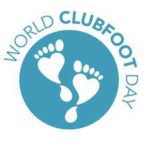The goal of world clubfoot day is to raise awareness about clubfoot disability and its prevention using non-surgical techniques such as the Ponseti method. In fact, World Clubfoot Day occurs on the 3rd of June because it was the birthday of the person who created the method Dr Ignacio Ponseti (1914-2009).

Clubfoot is a complex, congenital deformity of the foot also known as ‘congenital talipes equinovarus’ (CTEV) caused by the abnormal development of a baby’s bones, ligaments and muscles whilst in the womb. Around the world, 150,000 – 200,000 babies with clubfoot are born each year, approximately 80% of these will be in low and middle income countries.
Without treatment, the clubfoot deformity causes a lifetime of disability as the affected individual experiences pain and difficulty walking. People with untreated clubfoot find it difficult to access education, employment and experience exclusion from society.
It’s tragic that children go untreated considering that most cases of clubfoot can be successfully treated by a multidisciplinary team of healthcare workers with methods that may include a combination of stretching, casting, and bracing, the most common of which is the Ponseti method.
What is The Ponseti Method?
Since the 1970’s the Ponseti Method has grown in popularity and has completely replaced the previous methods of treating clubfoot in many countries. The Ponseti Method consists of 2 equally important phases: the Corrective Phase and the Maintenance Phase.
During the corrective phase the position of the foot is gradually corrected using a series of manipulations and plaster of Paris casts, then finally a small outpatient procedure is performed to cut the Achilles tendon (tenotomy). The corrective phase usually takes 4–8 weeks and the baby is seen weekly for the treatment.
After corrective phase has been finished and the foot is in a good position, the treatment is not over as the foot will tend to return to its deformed position, so the aim of the maintenance phase involves keeping the corrected position for the next 4–5 years. This is achieved by putting the child’s feet into a brace for 23 hours a day for the first 12 weeks then as night time until aged four or five.
How Can You Learn More about Clubfoot?
Learn on Physioplus
In 2017 Physiopedia, the International Committee of the Red Cross and the Global Clubfoot Initiative collaborated to deliver a MOOC on how to use the best practice available to manage children with clubfoot.
Over 7,000 clinicians from 156 countries took part in the MOOC with another 1,600 to take part since then. The overwheming majority have found the course enjoyable, the right length and content pitched at the right level. The course is still available for you to take part and is also available in French.
Free Resources on Physiopedia
There are over 30 Physiopedia pages dedicated to clubfoot. Below is a selection to get you started on the need-to-know basics for a firm foundation of knowledge on the condition.
- Introduction to Clubfoot
- Assessing Children with Clubfoot
- Management of Clubfoot
- Clubfoot Case Studies
Miracle Feet
MiracleFeet is on a mission to increase access to proper treatment for children born with clubfoot in low- and middle-income countries through partnerships with local healthcare providers. Physiopedia is proud to be collaborating with them as part of the ReLab-HS project.
As part of World Clubfoot Day they are sharing the story of Mr Clubfoot, a pioneer working in Uganda to train and mentor health workers who manage the condition. It’s a must watch story which will give you an insight into how healthcare systems can work together to create a lasting and meaningful impact on peoples lives.
This work is supported by the USAID funded Learning Acting Building for Rehabilitation in Health Systems (ReLAB-HS) project and is not possible without the generous and committed contribution of the Leahy War Victims fund.
ReLAB-HS is made possible by the generous support of the American people through the United States Agency for International Development (USAID) and is implemented under cooperative agreement number 7200AA20CA00033. The consortium is managed by prime recipient, Johns Hopkins Bloomberg School of Public Health.

